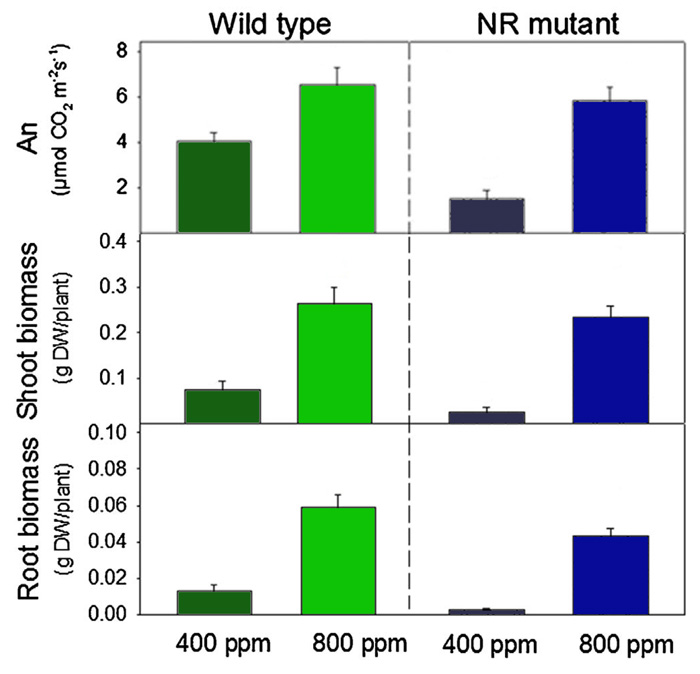| Follow @co2science |
Paper Reviewed
Jauregui, I., Aparicio-Tejo, P.M., Baroja, E., Avila, C. and Aranjuelo, I. 2017. Elevated CO2 improved the growth of a double nitrate reductase defective mutant of Arabidopsis thaliana: The importance of maintaining a high energy status. Environmental and Experimental Botany 140: 110-119.
Higher levels of atmospheric CO2 almost always lead to increased whole-plant nitrogen (N) content. However, because the increased N content is spread out across a larger CO2-enhanced amount of biomass, plant N concentration is often reduced, though usually by only a few percent (e.g., 1-6%). Such plant N concentration decline, however, can generally be overcome by supplying N-fertilization in the form of ammonium nitrate (NH4NO3), as opposed to just nitrate (NO3-). Yet the application of ammonium nitrate, when administered as the sole or nearly-sole source of N-fertilization, can induce plant ammonium toxicity, a debilitating condition that inhibits plant growth. Such an opposing set of growth-related circumstances recently led the scientific team of Jauregui et al. (2017) to investigate "whether elevated CO2 can alleviate ammonium stress" following ammonium nitrate application.
To answer this question, the team of five Spanish researchers grew two thale cress (Arabidopsis thaliana) ecotypes in a hydroponic culture for 28 days under two CO2 concentrations (400 or 800 ppm) in controlled-environment chambers. The two ecotypes included Columbia 0 (hereafter, wild type) and the Columbia 0 double nitrate reductase defective mutant nia1-1/chl3-5 (hereafter, NR mutant). The NR mutant ecotype was selected because it "preferentially assimilates ammonium as its nitrogen source" and, when compared with the wild ecotype, could provide information on how "the limitations of direct fertilization with ammonium (growth reduction attributed to ammonium toxicity) can be overcome [by the growth-enhancing effects of elevated CO2]." And what did their study reveal?
According to Jauregui et al., their results indicated that the NR mutant plants under ambient CO2 did indeed exhibit ammonium toxicity syndrome, evidenced by an enhancement of reactive oxygen species metabolism gene expression. However, under elevated CO2 conditions, the NR mutant plants, which are reliant on ammonium nutrition, exhibited plant growth and development that was "comparable to wild type plants," revealing that the NR mutant was "capable of using ammonium and nitrate." Indeed, as shown in the figure below, the NR mutant displayed reduced net photosynthesis and shoot and root biomass compared to the wild ecotype at ambient CO2. However, each of these parameters was enhanced under elevated CO2 to values that were equal or near to that which was observed in the wild type, demonstrating that elevated CO2 was able to alleviate ammonium stress in the NR mutant. And the magnitude of that alleviation was quite astounding; net photosynthesis, shoot biomass and root biomass in the NR mutant increased by 420, 970 and 1,620 percent relative to ambient in the NR mutant, whereas it increased by a lesser, though still impressive, 150, 350 and 460 percent in the wild type (see Figure 1 below).
In light of these several findings, Jauregui et al. conclude that their results "have shown that implementation of ammonium nutrition should enable plants to exploit the oncoming increases in atmospheric CO2." And that is good news worth reporting!

Figure 1. Effects of elevated CO2 on net photosynthesis (An), shoot biomass and root biomass of two thale cress (Arabidopsis thaliana) ecotypes (wild type and NR mutant). Adapted from Jauregui et al (2017).




